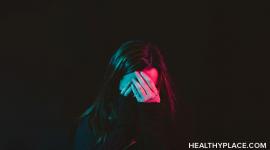Bipolar Depression and Light Therapy: Does It Really Work?

Bipolar depression and light therapy are a combination that both mental health professionals and people living with bipolar depression have wondered about for some time. The idea is attractive. Imagine practicing some quiet, relaxing self-care by sitting comfortably in front of a light and almost effortlessly reducing depression. Does it sound too good to be true? Perhaps surprisingly, light therapy for bipolar depression just might be effective, giving you another tool to overcome depressive episodes in bipolar disorder.
Light therapy, also called bright light therapy, involves exposure to a bright, full-spectrum light with a UV filter. Often, people sit in front of a light box, but some people prefer to wear a light visor for mobility. Either way, taking in full-spectrum light can be helpful in reducing bipolar depression.
Despite the need for more studies (existing studies, while promising, are small and thus limited), the American Psychiatric Association has stated that in bipolar depression, bright light therapy is an acceptable alternative or addition to medication and psychotherapy (Nasr, et al., 2018). In order to benefit from light therapy as well as avoid harm, it’s important to know how to properly use it.
Light Therapy and Bipolar Depression: How to Use It and Recommendations
Perhaps because it’s considered to be a medical treatment, lightbox instructions are given in dosages. A dose of light therapy involves a few important factors:
- The intensity of your light (measured in lux)
- Your distance from the lightbox
- Duration of your exposure
A common light therapy dose is between 5,000-7,000 lux for 15 to 60 minutes. Other doses are used, too, because each person is different. Light intensity and duration of exposure vary greatly, as illustrated by these examples:
- 400 lux for 2 hours per day
- 2000 lux for 2 hours per day
- 7000 lux for 45 to 60 minutes per day
- 10,000 lux for 45 to 60 minutes per day
Higher doses of intensity or duration may bring greater risks. It’s recommended that people starting bright light therapy for bipolar depression consult with their doctor for guidance on a dose that’s both safe and effective. Usually, people begin treatments with 15 minutes per day and work their way up to 60 minutes by 15-minute increments over the course of weeks.
Time of day is an important factor, too. The optimal time of day for bipolar depression and light therapy is around noon.
Effective distance and positioning is typically one foot away with your head at an approximately 45-degree angle to the light. It’s not necessary to stare directly into the light box. The light simply should enter your eyes at an angle between 30 and 60 degrees.
Benefits and Risks of Bright Light Therapy for Bipolar Depression
Thus far, researchers have observed more benefits to light therapy for bipolar depression than risks. Some observations in studies and by physicians using light therapy with patients include:
- Bipolar depression remission; in one study (Watson, 2018), over two-thirds of participants experienced remission
- Fairly quick response time; typically 4-6 weeks
- Non-invasive
- Minimal side effects
Such a positive response in a short time is a positive sign that light therapy can be effective in treating bipolar depression. Still, every treatment carries risks, and knowing the risks can help you make an informed decision about whether bright light therapy is right for you.
Side-effects that have been identified thus far include:
- Headaches
- Agitation
- Eye strain
- Menstrual irregularities (rare)
- Insomnia (this is less of a problem when light therapy is done no later than noon)
- Mania
Among the drawbacks of light therapy:
- Lightboxes can be expensive and usually aren’t covered by insurance
- It’s time-consuming
- Relapse is likely after stopping
Of all side-effects and drawbacks, perhaps the biggest one is the risk of entering a manic episode. Because of this danger, it’s important to consult with your doctor before beginning. Make sure that light therapy is right for you and your unique experience with bipolar disorder. Continue to touch base with your doctor throughout the process so they can monitor how you’re doing and adjust your dose as needed.
Lightbox therapy for bipolar depression has the potential to help people resume living full lives. Indeed, “Evidence suggests that bright light therapy is an effective, well-tolerated, and affordable adjunct treatment for bipolar depression “(Nasr, 2018).
APA Reference
Peterson, T.
(2021, December 28). Bipolar Depression and Light Therapy: Does It Really Work?, HealthyPlace. Retrieved
on 2025, December 23 from https://www.healthyplace.com/bipolar-disorder/bipolar-depression/bipolar-depression-and-light-therapy-does-it-really-work



